Master the art of microgreens water management and unlock the secret to consistently thriving, nutrient-dense harvests. From understanding the critical role of water pH to implementing professional bottom watering techniques, this comprehensive guide covers everything you need to know about watering microgreens successfully.
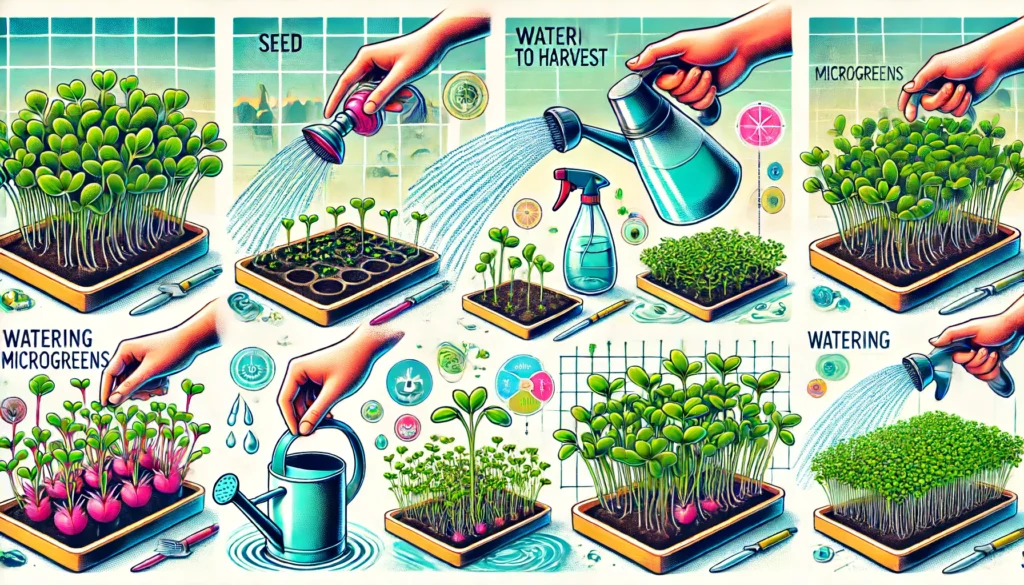
Growing healthy microgreens isn’t just about good seeds and proper lighting – microgreens water quality and management play a crucial role in determining your harvest success. Whether you’re dealing with hard water, trying to perfect your pH levels, or implementing soilless growing methods, understanding water management is essential for consistent, professional-quality results.
Many growers struggle with common watering mistakes that can lead to stunted growth, mold issues, or complete crop failure. The difference between mediocre and exceptional microgreens often comes down to mastering the fundamentals of water management, including proper timing, pH balance, and delivery methods.
Understanding Microgreens Water Requirements
The microgreens water needs vary significantly throughout the growing cycle, from initial seeding to harvest. Unlike mature plants, microgreens have a compressed growth cycle that demands precise water management to achieve optimal results.
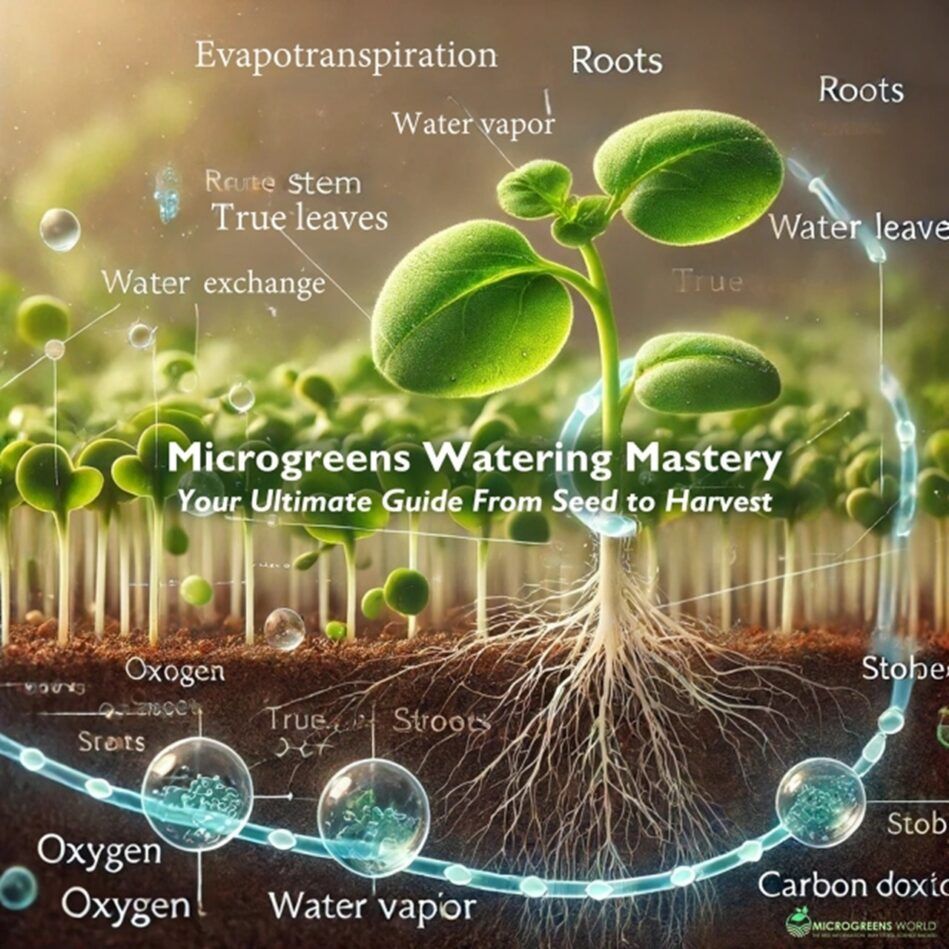
Research shows that microgreens can transpire approximately 1.5 to 2.5 fluid ounces of water per day in a standard 10×20 tray during peak growth. This process, called evapotranspiration, involves plants absorbing water through roots, transporting it to leaves, and releasing it through stomata. Environmental factors like temperature, humidity, and air circulation significantly influence this rate.
Factors Affecting Microgreens Water Needs
Several key factors determine how much and how often you need to water your microgreens:
- Growth Stage: Newly germinated seeds require less water than mature microgreens approaching harvest
- Variety Type: Larger varieties like pea shoots need more water than smaller varieties like broccoli microgreens
- Growing Medium: Soil retains moisture differently than soilless substrates like coconut coir
- Environmental Conditions: Temperature, humidity, and air circulation affect water consumption rates
- Tray Size and Depth: Deeper trays with more growing medium require different watering approaches
Pro Tip: Use your finger as a moisture meter. Insert it into the growing medium to check moisture levels. It should feel like a damp sponge – moist but not waterlogged.
The Science of Water pH for Microgreens
The pH of your microgreens water directly impacts nutrient availability and plant health. Most microgreens thrive in slightly acidic conditions with a pH between 5.5 and 6.5, which optimizes nutrient uptake and prevents common growing problems.
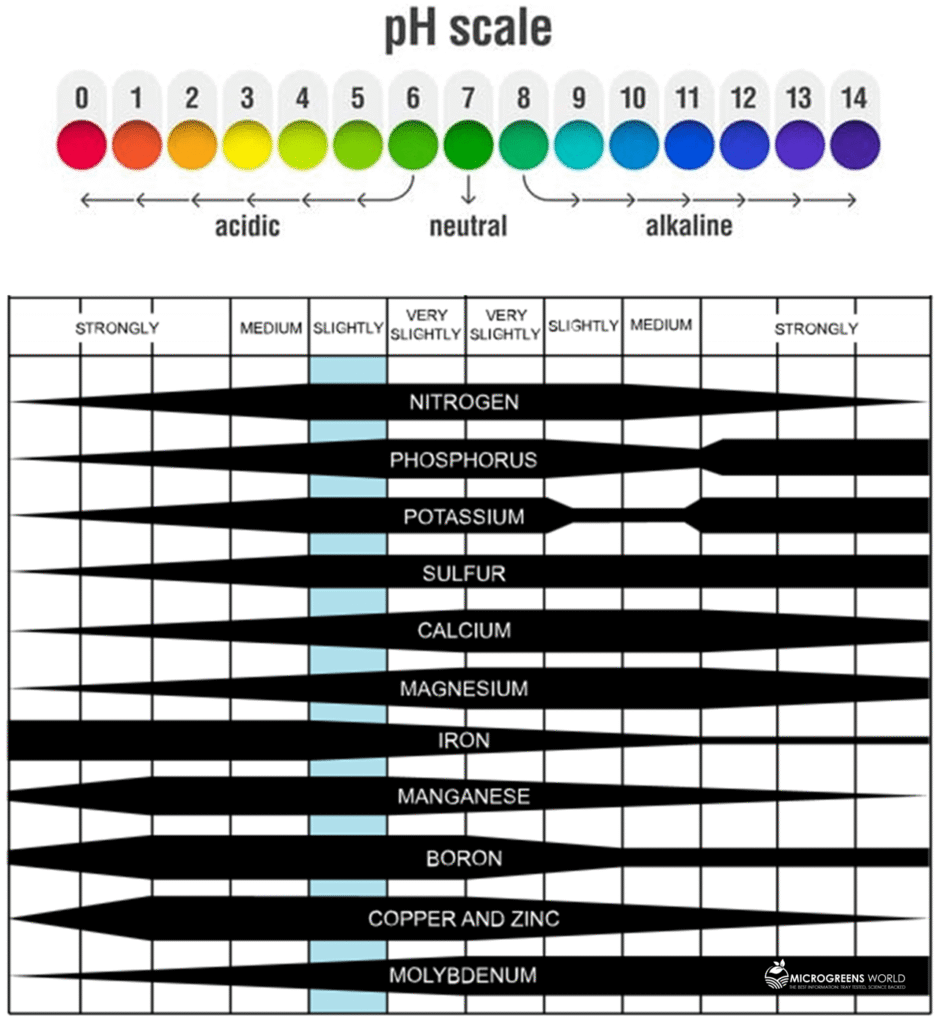
Most municipal tap water has a pH of 7.0-8.0, making it too alkaline for optimal microgreens growth. Hard water with high mineral content can push pH even higher, creating nutrient lockout conditions that prevent plants from absorbing essential minerals.
Testing and Adjusting Water pH
Regular pH testing is essential for consistent results. You can test your water using:
- Digital pH Meters: Most accurate but require calibration
- pH Test Strips: Affordable and easy to use for basic testing
- Liquid pH Test Kits: Color-change indicators for quick assessment
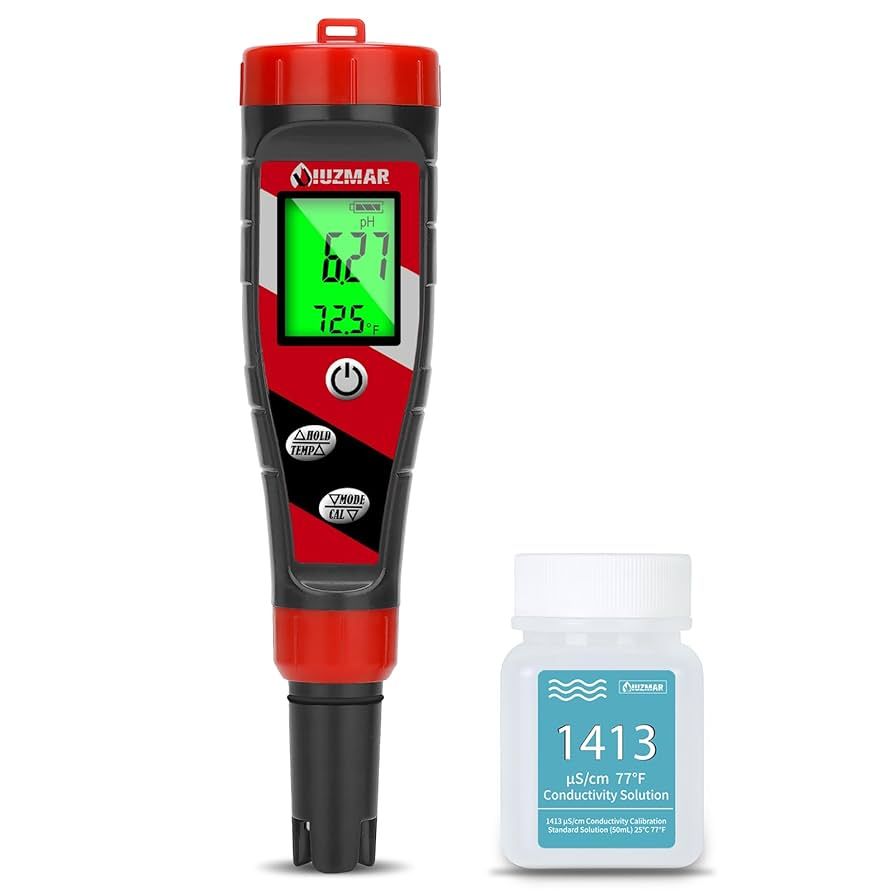
Natural pH Adjustment Methods
To lower alkaline water pH naturally:
- Lemon Juice: Add 1-2 drops per gallon of water
- White Vinegar: Use 1-2 teaspoons per gallon
- pH Down Solutions: Commercial products designed for hydroponic use
Important: Always test pH after adjustments and allow water to sit for 30 minutes before retesting, as pH can drift initially.
Water Quality and Filtration Systems
The quality of your microgreens water significantly impacts plant health and growth rates. Common tap water contaminants include chlorine, chloramines, fluoride, and heavy metals that can inhibit growth and affect flavor.
Common Water Quality Issues
Hard water presents unique challenges for microgreens cultivation:
- High Mineral Content: Calcium and magnesium can raise pH and interfere with nutrient uptake
- Chlorine and Chloramines: Disinfectants that can damage beneficial microorganisms
- Fluoride: Can accumulate in plants and affect growth
- Heavy Metals: Lead, copper, and other contaminants from old pipes
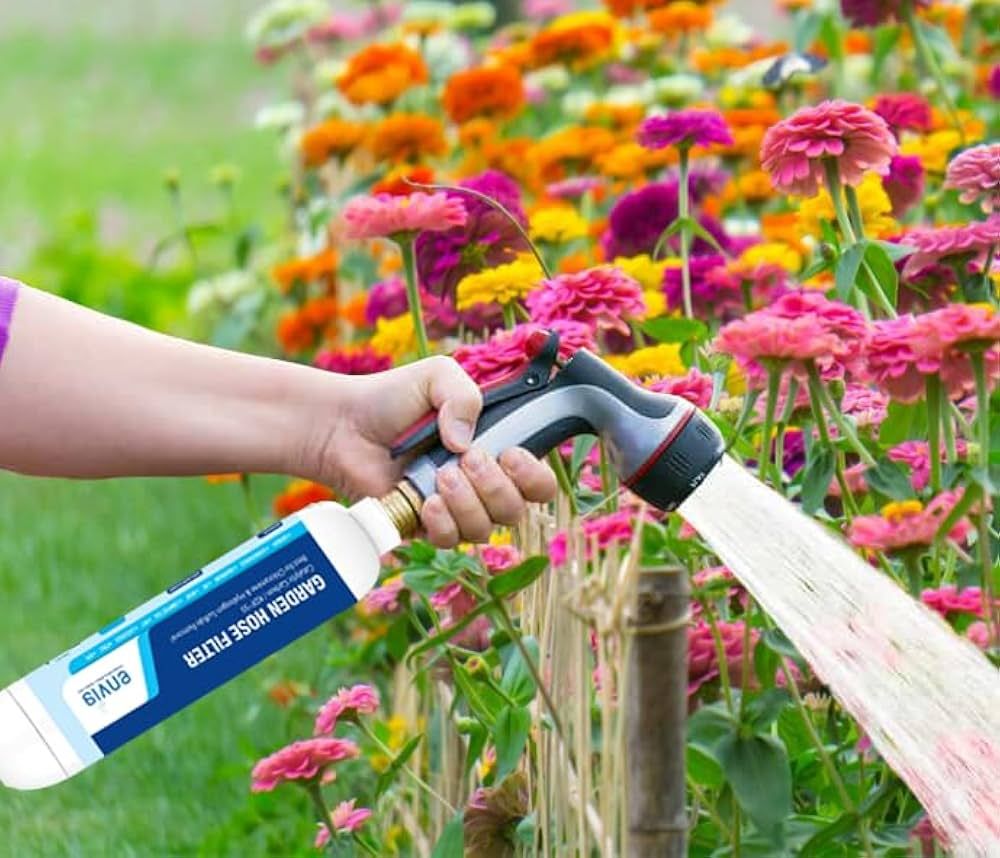
Effective Water Filtration Solutions
Choose the right filter system based on your water quality and growing scale:
| Filter Type | Removes | Best For | Cost |
|---|---|---|---|
| Activated Carbon | Chlorine, odors, taste | Basic filtration | Low |
| Reverse Osmosis | Most contaminants | Complete purification | High |
| Catalytic Carbon | Chloramines, chemicals | Hard water areas | Medium |
| Sediment Filters | Particles, rust | Pre-filtration | Low |
Budget-Friendly Water Treatment Options
For small-scale growers, simple solutions can improve water quality:
- 24-Hour Sitting: Let tap water sit overnight to allow chlorine to evaporate
- Vitamin C Tablets: Add ascorbic acid to neutralize chlorine and chloramines
- Boiling: Boil water for 15 minutes to remove chlorine (not practical for large volumes)
Mastering Bottom Watering Techniques
Bottom watering is the gold standard for microgreens water delivery after germination. This method provides even moisture distribution while preventing mold and protecting delicate stems from damage.
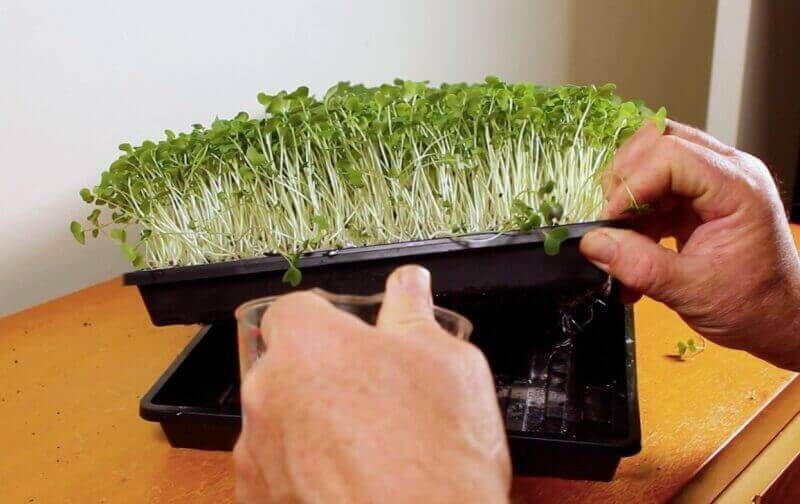
Step-by-Step Bottom Watering Process
Follow these steps for effective bottom watering:
- Lift the Growing Tray: Carefully lift the tray with drainage holes from one end
- Add Water Slowly: Pour 1-2 cups of pH-adjusted water into the bottom tray
- Lower Tray Gently: Slowly lower the growing tray to avoid splashing
- Check Absorption: Wait 20 minutes and check if the growing medium is evenly moist
- Adjust as Needed: Add more water if needed, or reduce amount for next watering
- Drain Excess: Remove any standing water after 30 minutes
Expert Tip: Never leave standing water in the bottom tray for more than 30 minutes. This can lead to root rot and anaerobic conditions.
Watering Frequency Guidelines
The frequency of watering depends on several factors:
- Germination Stage: Mist 1-2 times daily to keep seeds moist
- Early Growth: Bottom water once daily with 1 cup water
- Mature Growth: Water twice daily with 1-2 cups per session
- Pre-Harvest: Large varieties may need 2-3 cups twice daily
Soilless Growing and Water Management
Soilless growing methods require specialized water management approaches. These systems offer greater control over nutrients and pH while eliminating soil-borne pathogens.

Popular Soilless Growing Media
Each soilless medium requires different water management approaches:
- Coconut Coir: Retains moisture well but drains slowly
- Perlite: Excellent drainage but requires frequent watering
- Vermiculite: High water retention, good for water-loving varieties
- Hydroponic Mats: Consistent moisture wicking properties
- Rockwool: Sterile and consistent but requires pH adjustment
Nutrient Solutions for Soilless Systems
When growing soilless, you may need to add nutrients to your water solution:
| Nutrient Type | Concentration | When to Use |
|---|---|---|
| Liquid Kelp | 1-2 ml per gallon | Throughout growth cycle |
| Fish Emulsion | 1 tsp per gallon | After cotyledon stage |
| Hydroponic Solution | 1/4 strength | For longer growing cycles |
Automated Watering Systems
Automatic watering systems can streamline your microgreens operation while ensuring consistent moisture levels. These systems are particularly valuable for commercial growers or those managing large numbers of trays.
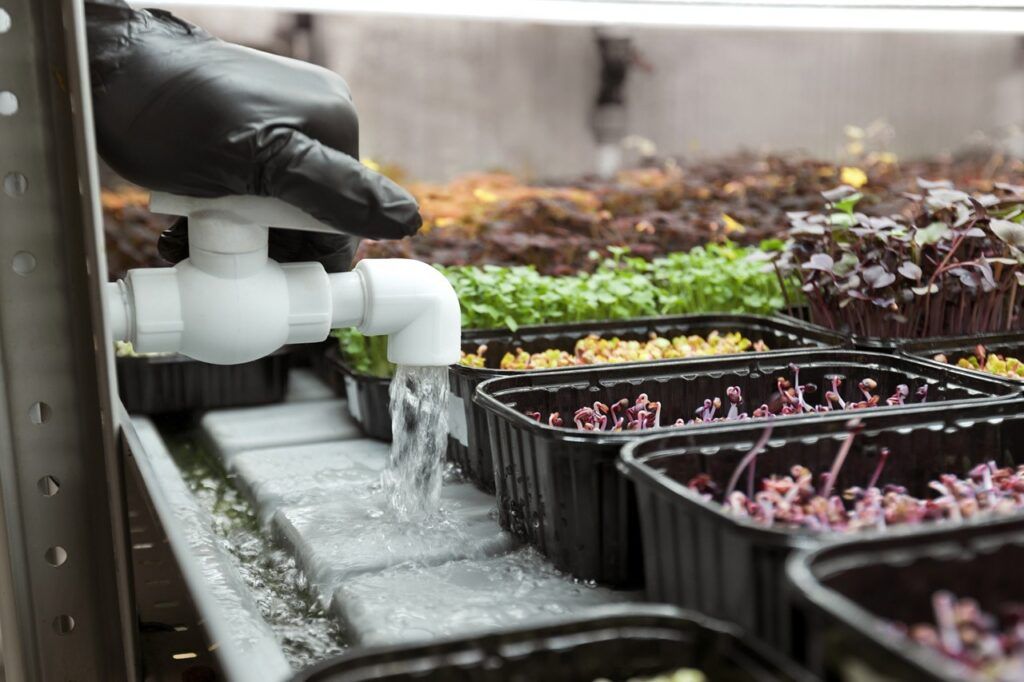
Types of Automated Systems
Several automatic watering options are available:
- Drip Irrigation: Precise water delivery directly to growing medium
- Misting Systems: Fine spray for germination and early growth
- Ebb and Flow: Timed flooding and draining cycles
- Capillary Mat Systems: Passive wicking from water reservoir
DIY Automated Solutions
Budget-conscious growers can create simple automatic systems:
- Timer-Controlled Misters: Programmable spray bottles with timers
- Gravity-Fed Systems: Elevated water reservoirs with drip controls
- Capillary Wicking: Fabric strips connecting water reservoir to trays
Common Microgreens Watering Mistakes
Avoiding these common errors will significantly improve your microgreens success rate:
Top Watering Mistakes
- Overwatering: Leads to root rot and fungal issues
- Inconsistent Timing: Irregular watering schedules stress plants
- Wrong Water Temperature: Cold water can shock roots
- Poor Drainage: Standing water creates anaerobic conditions
- Ignoring pH: Alkaline water prevents nutrient uptake
Critical Mistake: Never water microgreens from above after germination. This can damage delicate stems and promote mold growth on the soil surface.
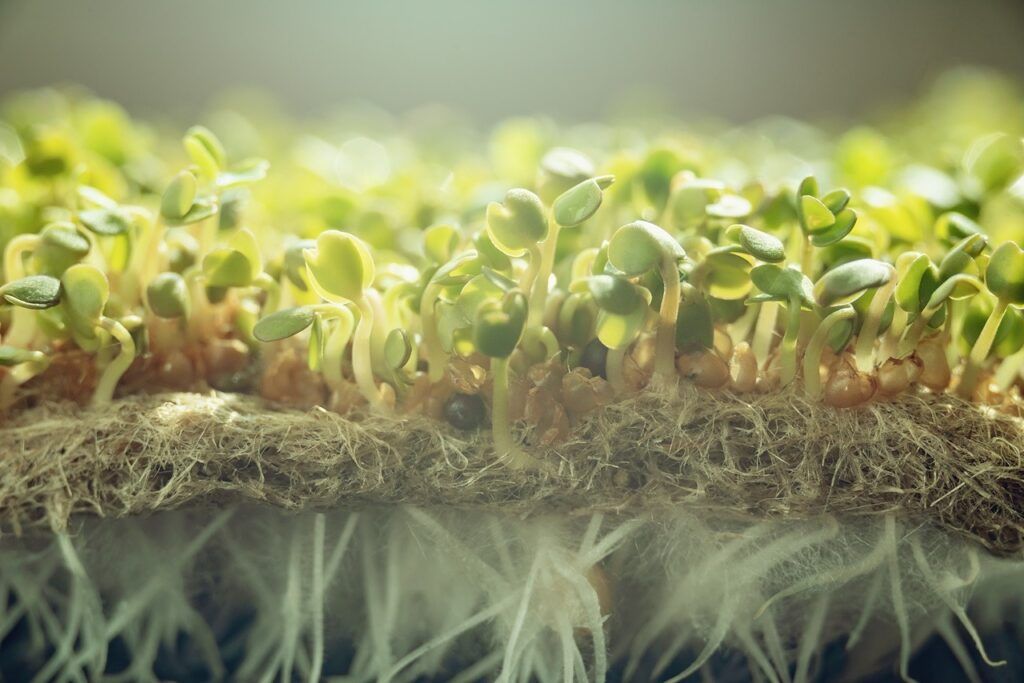
Identify and solve water-related issues quickly:
- Wilting: Usually indicates underwatering or root problems
- Yellowing: Can indicate overwatering or nutrient lockout
- Mold Growth: Too much moisture and poor air circulation
- Stunted Growth: Poor water quality or pH issues
- Uneven Growth: Inconsistent watering or poor water distribution
Advanced Water Management Strategies
Professional growers use advanced techniques to optimize microgreens water management:
Water Scheduling by Growth Phase
Adjust your watering schedule based on growth phases:
- Pre-Germination: Soak seeds if required, then mist growing medium
- Blackout Period: Minimal watering to maintain humidity
- Light Exposure: Increase watering frequency as photosynthesis begins
- Rapid Growth: Peak water demand period
- Pre-Harvest: Reduce watering to concentrate flavors
Environmental Optimization
Control environmental factors to reduce watering needs:
- Humidity Control: Maintain 50-70% humidity to reduce evaporation
- Temperature Management: Keep temperatures between 65-75°F
- Air Circulation: Gentle airflow prevents mold without over-drying
- Light Intensity: Proper lighting reduces stress and water needs
Seasonal Water Management Considerations
Adjust your microgreens water management based on seasonal changes:
Summer Watering Strategies
- Increase watering frequency due to higher temperatures
- Monitor for heat stress and increase humidity
- Use cooler water to help regulate temperature
- Consider additional air circulation to prevent mold
Winter Watering Adjustments
- Reduce watering frequency in cooler conditions
- Watch for condensation and mold issues
- Use room temperature water to avoid cold shock
- Maintain consistent humidity levels
Water Quality Testing and Monitoring
Regular testing ensures optimal microgreens water quality:
Essential Water Tests
- pH Testing: Daily monitoring for consistent results
- TDS (Total Dissolved Solids): Measure mineral content
- Chlorine Testing: Ensure proper dechlorination
- Temperature Monitoring: Maintain optimal water temperature
Monthly Water Quality Assessment
Conduct comprehensive monthly water quality checks:
- Test source water quality for changes
- Evaluate filter performance and replace as needed
- Check pH adjustment effectiveness
- Monitor plant health indicators
Frequently Asked Questions About Microgreens Water
What pH do microgreens need for optimal water?
Microgreens thrive best with slightly acidic water having a pH between 5.5 and 6.5. Most tap water is alkaline with pH around 7-8, so you’ll need to adjust it using pH test strips and natural acidifiers like lemon juice or vinegar.
How often should I water microgreens?
Water microgreens once daily during germination, increasing to twice daily as they grow larger. Check soil moisture by inserting your finger into the growing medium – it should feel like a damp sponge, not soaking wet.
Can I use hard water for microgreens?
Hard water with high mineral content can hinder microgreens growth. Use a water filter, reverse osmosis system, or let tap water sit 24 hours to reduce chlorine. Test your water’s pH and adjust as needed.
What’s the best way to water microgreens?
Bottom watering is the best method for microgreens after germination. Add water to the bottom tray and let it wick up through drainage holes. This prevents mold, protects delicate stems, and ensures even moisture distribution.
Do I need to filter water for microgreens?
Yes, filtering water removes chlorine, fluoride, and other chemicals that can inhibit growth. Use activated carbon filters, reverse osmosis systems, or let tap water sit overnight to dechlorinate naturally.
When should I stop watering microgreens before harvest?
Reduce watering 12-24 hours before harvest to concentrate flavors and make harvesting easier. The growing medium should still be slightly moist but not wet to prevent wilting.
Can I use rainwater for microgreens?
Rainwater can be excellent for microgreens as it’s naturally soft and slightly acidic. However, test the pH and ensure it’s collected cleanly to avoid contamination from roof runoff or pollutants.
Conclusion: Mastering Microgreens Water for Success
Successful microgreens water management combines science with practical experience. By understanding pH requirements, implementing proper bottom watering techniques, and addressing hard water challenges, you can achieve consistent, professional-quality harvests.
Remember that water quality is just as important as quantity. Whether you’re growing in soil or soilless systems, maintaining proper pH levels and using clean, filtered water will dramatically improve your results.
Start with these fundamental principles, monitor your plants closely, and adjust your approach based on environmental conditions and plant response. With consistent practice and attention to detail, you’ll develop the intuition needed to provide optimal microgreens water management for thriving, nutrient-dense harvests.
Final Tip: Keep a growing journal to track watering schedules, environmental conditions, and plant responses. This data will help you refine your techniques and achieve more consistent results over time.


